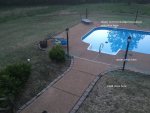I have read almost every floating liner post there is. I feel like most solutions don't apply to my situation. Under heavy rains water seems to pour in under the deck into some kind of void and then trickle over top edge of the wall between wall and liner. This is an inground pool. I drew a little diagram to explain. This problem developed over time. I don't know why the void now and it's only recently causing the problem. Pool is about 7 years old. Water will trickle over top of wall and start a bubble in the 3ft end above the water line and the bubble and water will make its way around the entire pool wall. Under severe rains it makes it's way down to the floor area. Since my source of water is coming from surface water, I don't think a sump pit would work. Also I have clay soil so that doesn't help. I was considering something like the nu-flo drainage system but I don't know that that product is made anymore. The other solution I though to do was french drains around the edge of pool deck to capture the water and release it elsewhere so it doesn't get a chance to pool up under the deck and make it's way over top of the wall.




